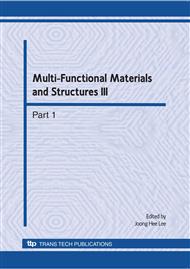p.895
p.899
p.903
p.907
p.911
p.915
p.919
p.923
p.927
Temperature Independent Delamination Detection Using Data Normalization
Abstract:
This paper describes a new delamination detection technique for a composite structure under varying temperature. Guided waves and impedances have the merits of being sensitive to small defects of a structure. However, they can be vulnerable to environmental and operational variations. In reality, structures are subject to various environmental and operational conditions that affect measured guided wave and impedance signals, and these ambient variations can often lead false alarms. To tackle this issue, a data normalization procedure that distinguishes structural damage from undesirable ambient variations, is developed. The overall procedures of the proposed method are (1) the temperature estimation from impedance data using data normalization, (2) the selection of guided wave signals related to the estimated temperature, and (3) damage classification based on generalized extreme value statistics. In order to validate the proposed method, experimental studies under varying temperature are investigated in a composite plate.
Info:
Periodical:
Pages:
911-914
Citation:
Online since:
August 2010
Authors:
Price:
Сopyright:
© 2010 Trans Tech Publications Ltd. All Rights Reserved
Share:
Citation:


